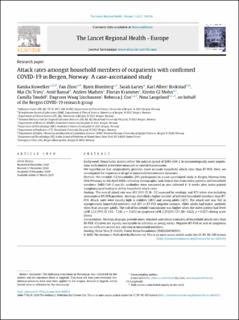Attack rates amongst household members of outpatients with confirmed COVID-19 in Bergen, Norway: A case-ascertained study
Kuwelker, Kanika; Zhou, Fan; Blomberg, Bjørn; Jalloh, Sarah Larteley Lartey; Brokstad, Karl Albert; Trieu, Mai Chi; Bansal, Amit; Madsen, Anders; Krammer, Florian; Mohn, Kristin Greve-Isdahl; Tøndel, Camilla; Linchausen, Dagrunn Waag; Cox, Rebecca Jane; Langeland, Nina
Journal article, Peer reviewed
Published version

Åpne
Permanent lenke
https://hdl.handle.net/11250/2990274Utgivelsesdato
2021Metadata
Vis full innførselSamlinger
- Department of Clinical Science [2379]
- Registrations from Cristin [10237]
Sammendrag
Background
Households studies reflect the natural spread of SARS-CoV-2 in immunologically naive populations with limited preventive measures to control transmission.
We hypothesise that seropositivity provides more accurate household attack rates than RT-PCR. Here, we investigated the importance of age in household transmission dynamics.
Methods
We enroled 112 households (291 participants) in a case-ascertained study in Bergen, Norway from 28th February to 4th April 2020, collecting demographic and clinical data from index patients and household members. SARS-CoV-2-specific antibodies were measured in sera collected 6–8 weeks after index patient nasopharyngeal testing to define household attack rates.
Findings
The overall attack rate was 45% (95% CI 38–53) assessed by serology, and 47% when also including seronegative RT-PCR positives. Serology identified a higher number of infected household members than RT-PCR. Attack rates were equally high in children (48%) and young adults (42%). The attack rate was 16% in asymptomatic household members and 42% in RT-PCR negative contacts. Older adults had higher antibody titres than younger adults. The risk of household transmission was higher when the index patient had fever (aOR 3.31 [95% CI 1.52–7.24]; p = 0.003) or dyspnoea (aOR 2.25 [95% CI 1.80–4.62]; p = 0.027) during acute illness.
Interpretation
Serological assays provide more sensitive and robust estimates of household attack rates than RT-PCR. Children are equally susceptible to infection as young adults. Negative RT-PCR or lack of symptoms are not sufficient to rule out infection in household members.
